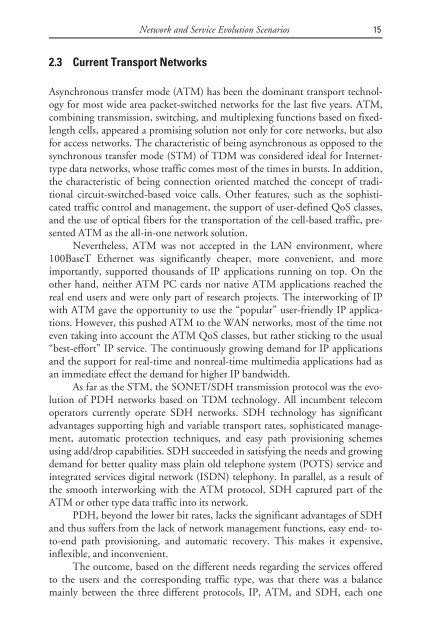deploying and managing ip over wdm networks - Index of
deploying and managing ip over wdm networks - Index of
deploying and managing ip over wdm networks - Index of
You also want an ePaper? Increase the reach of your titles
YUMPU automatically turns print PDFs into web optimized ePapers that Google loves.
2.3 Current Transport Networks<br />
Network <strong>and</strong> Service Evolution Scenarios 15<br />
Asynchronous transfer mode (ATM) has been the dominant transport technology<br />
for most wide area packet-switched <strong>networks</strong> for the last five years. ATM,<br />
combining transmission, switching, <strong>and</strong> mult<strong>ip</strong>lexing functions based on fixedlength<br />
cells, appeared a promising solution not only for core <strong>networks</strong>, but also<br />
for access <strong>networks</strong>. The characteristic <strong>of</strong> being asynchronous as opposed to the<br />
synchronous transfer mode (STM) <strong>of</strong> TDM was considered ideal for Internettype<br />
data <strong>networks</strong>, whose traffic comes most <strong>of</strong> the times in bursts. In addition,<br />
the characteristic <strong>of</strong> being connection oriented matched the concept <strong>of</strong> traditional<br />
circuit-switched-based voice calls. Other features, such as the sophisticated<br />
traffic control <strong>and</strong> management, the support <strong>of</strong> user-defined QoS classes,<br />
<strong>and</strong> the use <strong>of</strong> optical fibers for the transportation <strong>of</strong> the cell-based traffic, presented<br />
ATM as the all-in-one network solution.<br />
Nevertheless, ATM was not accepted in the LAN environment, where<br />
100BaseT Ethernet was significantly cheaper, more convenient, <strong>and</strong> more<br />
importantly, supported thous<strong>and</strong>s <strong>of</strong> IP applications running on top. On the<br />
other h<strong>and</strong>, neither ATM PC cards nor native ATM applications reached the<br />
real end users <strong>and</strong> were only part <strong>of</strong> research projects. The interworking <strong>of</strong> IP<br />
with ATM gave the opportunity to use the “popular” user-friendly IP applications.<br />
However, this pushed ATM to the WAN <strong>networks</strong>, most <strong>of</strong> the time not<br />
even taking into account the ATM QoS classes, but rather sticking to the usual<br />
“best-effort” IP service. The continuously growing dem<strong>and</strong> for IP applications<br />
<strong>and</strong> the support for real-time <strong>and</strong> nonreal-time multimedia applications had as<br />
an immediate effect the dem<strong>and</strong> for higher IP b<strong>and</strong>width.<br />
As far as the STM, the SONET/SDH transmission protocol was the evolution<br />
<strong>of</strong> PDH <strong>networks</strong> based on TDM technology. All incumbent telecom<br />
operators currently operate SDH <strong>networks</strong>. SDH technology has significant<br />
advantages supporting high <strong>and</strong> variable transport rates, sophisticated management,<br />
automatic protection techniques, <strong>and</strong> easy path provisioning schemes<br />
using add/drop capabilities. SDH succeeded in satisfying the needs <strong>and</strong> growing<br />
dem<strong>and</strong> for better quality mass plain old telephone system (POTS) service <strong>and</strong><br />
integrated services digital network (ISDN) telephony. In parallel, as a result <strong>of</strong><br />
the smooth interworking with the ATM protocol, SDH captured part <strong>of</strong> the<br />
ATM or other type data traffic into its network.<br />
PDH, beyond the lower bit rates, lacks the significant advantages <strong>of</strong> SDH<br />
<strong>and</strong> thus suffers from the lack <strong>of</strong> network management functions, easy end- toto-end<br />
path provisioning, <strong>and</strong> automatic rec<strong>over</strong>y. This makes it expensive,<br />
inflexible, <strong>and</strong> inconvenient.<br />
The outcome, based on the different needs regarding the services <strong>of</strong>fered<br />
to the users <strong>and</strong> the corresponding traffic type, was that there was a balance<br />
mainly between the three different protocols, IP, ATM, <strong>and</strong> SDH, each one


